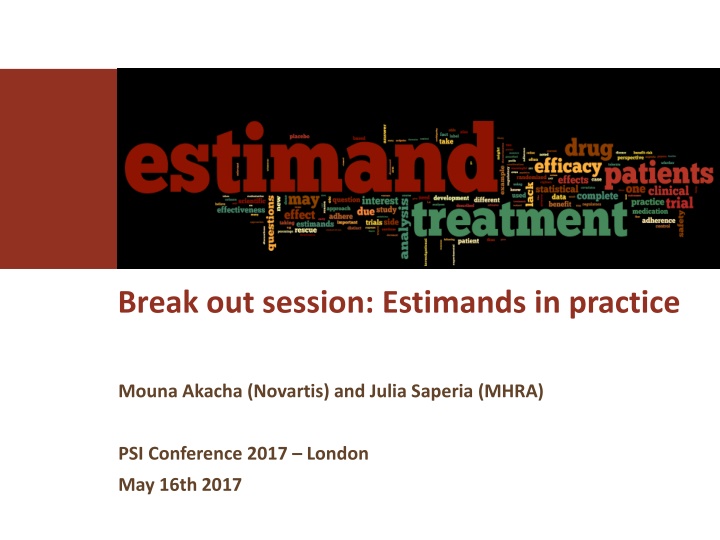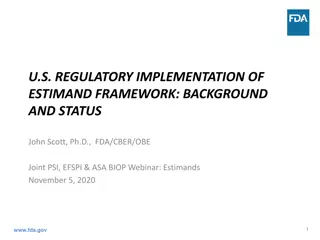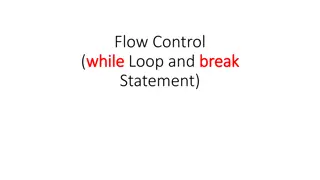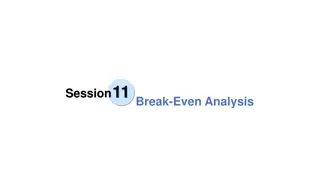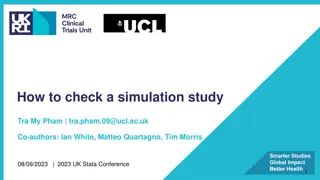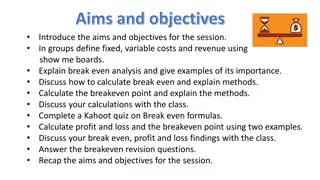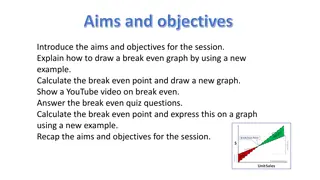Break out session: Estimands in practice
This session at the PSI Conference 2017 in London delves into the practical implementation of estimands by Mouna Akacha from Novartis and Julia Saperia from MHRA. Gain insights into real-world applications and challenges faced in using estimands in research and analysis.
Download Presentation

Please find below an Image/Link to download the presentation.
The content on the website is provided AS IS for your information and personal use only. It may not be sold, licensed, or shared on other websites without obtaining consent from the author.If you encounter any issues during the download, it is possible that the publisher has removed the file from their server.
You are allowed to download the files provided on this website for personal or commercial use, subject to the condition that they are used lawfully. All files are the property of their respective owners.
The content on the website is provided AS IS for your information and personal use only. It may not be sold, licensed, or shared on other websites without obtaining consent from the author.
E N D
Presentation Transcript
Break out session: Estimands in practice Mouna Akacha (Novartis) and Julia Saperia (MHRA) PSI Conference 2017 London May 16th 2017
Aim Gain familiarity in deciding on estimands and apply structured framework in different clinical trial settings Chronic pain Asthma Cancer-related wasting syndrome 2
Estimands A. Population Subjects targeted by the scientific question B. Variable C. Intervention effect of interest Quantities required to address the scientific question D. Summary measure How potential intercurrent events are reflected in the scientific question On which the treatment comparison will be based 3
A lot of this boils down to... How do we account for intercurrent events that themselves are informative about the effects of treatment? E.g. study treatment discontinuation due to AE or LoE, intake of rescue or concomitant medication, inevaluable tumor assessment, switch to new anti- neoplastic therapy (ANP), death etc. Treatment discontinuation due to lack of efficacy Patient 1 Treatment complete Patient 2 ? Study discontinuation Patient 3 Rescue medication Patient 4 Death Patient 5 Treatment discontinuation due to adverse events Study discontinuation ? Patient 6 Rescue medication Patient 7 Randomisation Primary endpoint TIMELINE 4
Some estimand approaches Treatment-Policy: Consider the variable regardless of whether the intercurrent event has occurred Composite: Define the intercurrent event as a component of a composite variable Hypothetical: Consider a given hypothetical outcome associated with the intercurrent event Principal Stratum: Focus on the stratum of patients in which an intercurrent event would not occur While-on-treatment: Consider the variable up to the time of the intercurrent event 5
Structured framework to bridge trial objectives with statistical inference Trial Objective Estimand (informing the trial design) Main Estimator Sensitivity Estimator ? Sensitivity Estimator 1 ... Main Estimate Sensitivity Estimate ? Sensitivity Estimate 1 ... 6
Case studies For these case studies each table will focus on one case study and discuss the choice of estimands for licensing purposes (~ 50 minutes) Justify your choice and if time allows discuss main and sensitivity estimators choices of estimands and estimators will be shared and discussed in the last 30 minutes Group s responsibility to identify a person to feed back Note: For the case studies we assume a certain design is given with the new framework the estimand choice should drive/inform design choice. 7
Case study 1 Chronic pain Randomised, double-blind, placebo-controlled phase III study Compare a Drug X versus Placebo (on top of stable standard of care) in the treatment of chronic pain Measurement of clinical interest: Change from baseline in pain score at week 12 Week 12 Placebo Drug X May take prohibited medication or rescue medication in periods where pain is not well controlled patients are followed up regardless May change stable SoC doses May discontinue study or treatment for various reasons, e.g. AEs and lack of efficacy 8 8
Case study 2 Asthma Randomised, double-blind, active-controlled phase III study Inhaled corticosteroid (ICS) + long-acting beta agonist (LABA) + long-acting muscarinic antagonist (LAMA) vs ICS + LABA ICS + LABA + LAMA vs ICS + LABA both are fixed dose combination products Measurement of clinical interest: Change from baseline in lung function at week 24 Week 24 ICS + LABA ICS + LABA + LAMA Unbalanced treatment discontinuations expected more in ICS + LABA arm Alternative medication is given after stopping of randomised treatment Randomised treatment must stop and rescue given if severe exacerbation occurs 9
Case study 3 Cancer-related wasting syndrome Randomised, double-blind, placebo-controlled phase III study Compare Drug X against placebo for weight gain in late-stage cancer Measurement of clinical interest: Change from baseline in body weight at week 12 Week 12 Placebo Drug X Some patients die before the end of 12 weeks Death may or may not be related to wasting syndrome 10
What would be appropriate estimands? Note: Should you require more information on the specific settings to decide on the estimand then Write down the information needed Consider different scenarios related to this additional information Decide on estimands in the different scenarios Moderators will help you 11
Moderators Mouna Akacha Julie Anderson Anna Berglind Robert Cuffe Christine Fletcher Lisa LaVange Michael O Kelly Alan Phillips James Roger Kaspar Rufibach Julia Saperia David Wright - Novartis - GSK - AstraZeneca - GSK - Amgen - FDA - Quintiles - ICON - LSHTM - Roche - MHRA - AstraZeneca 12
Additional considerations What if the comparator was standard of care instead of placebo? Would you change your mind if your main focus was the patient s or physician s perspective? If you could, would you change anything in the design? What if we were interested in non-inferiority instead of superiority? 13
